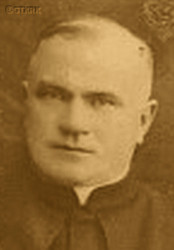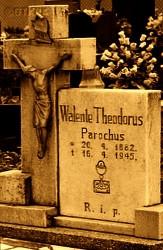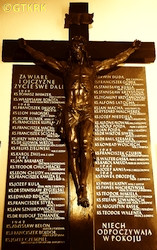Roman Catholic
St Sigismund parish
05-507 Słomczyn
85 Wiślana Str.
Konstancin deanery
Warsaw archdiocese, Poland
full list:
displayClick to display full list

searchClick to search full list by categories
wyświetlKliknij by wyświetlić pełną listę po polsku

szukajKliknij by przeszukać listę wg kategorii po polsku

Martyrology of the clergy — Poland
XX century (1914 – 1989)
personal data
surname
WALENTA
forename(s)
Theodore Henry (pl. Teodor Henryk)
function
diocesan priest
creed
Latin (Roman Catholic) Church RCmore on
en.wikipedia.org
[access: 2014.09.21]
congregation
Society of St Francis de Sales SDBmore on
en.wikipedia.org
[access: 2013.05.19]
(i.e. Salesians of Don Bosco)
diocese / province
Katowice diocesemore on
en.wikipedia.org
[access: 2013.05.19]
Wrocław diocesemore on
en.wikipedia.org
[access: 2013.05.19]
honorary titles
Cross on the Silesian Ribbon of Valor and Merit
(1930)
Gold „Cross of Merit”more on
en.wikipedia.org
[access: 2019.04.16]
(07.11.1929)
date and place
of death
16.04.1945

Gorzycetoday: Gorzyce gm., Wodzisław Śląski pov., Silesia voiv., Poland
more on
en.wikipedia.org
[access: 2021.04.02]
details of death
After World War I, when the fate of Silesia region was to be decided — during Silesian Uprisings and Versaille mandated plebiscite (1919‐1921) — Polish activist supporting Polish claims to Silesia.
French and Italian language interpreter at Inter–Allied Governing and Plebiscite Commission in Upper Silesia located in Opole and speaker at public educational meetings organised by Polish Plebiscite Committee headquartered in Bytom.
In 1933, after crossing the Polish–German border post Wilcza Góra – Pilchowice, apprehended, battered and finally arrested for a short time by the German border authorities — for a sermon delivered on the Polish national holiday on 03.05.1933, in which mentioned the persecution of Poles in Germany.
Before the outbreak of the World War II got partially paralysed and that prob. saved him from German concentration camps.
After German and Russian invasion of Poland in 09.1939 and start of the World War II, after start of German occupation, interrogated by the Germans.
Forbidden to conduct any religious liturgical ceremonies and locked under a strict house arrest.
In 1945, during Russian winter offensive of 1945 ending the military conflict of the World War II, in the light of imminent Germany collapse, hid a number of parishioners in the cellars of his rectory.
After Russian capture of his village — during the so‐called Moravian–Ostrava Operation of 10.03.1945‐05.05.1945, when nearby Wodzisław Śląski was taken over by the Russians on 26.03.1945 — drunken Russian soldiers entered the rectory on 16.04.1945 and discovered a cellar.
Stood up to defend women hiding there and was shot by a Russian soldier.
Bleeding taken out the rectory, murdered and thrown into a ditch.
alt. details of death
According to other sources dragged out of the cellar.
Beaten, harrassed, deprived of his stole and purse with corporal, called Rus. „cziorny czort” (Eng. „Black devil”), led to a local Russian commander.
There subjected to further torture and then shot.
cause of death
mass murder
perpetrators
Russians
sites and events
Mass rapes in 1945Click to display the description, «Intelligenzaktion Schlesien»Click to display the description, «Intelligenzaktion»Click to display the description, Ribbentrop‐MolotovClick to display the description, Pius XI's encyclicalsClick to display the description
date and place
of birth
20.04.1882

Pawłówtoday: Pietrowice Wielkie gm., Racibórz pov., Silesia voiv., Poland
more on
en.wikipedia.org
[access: 2022.01.09]
parents
WALENTA Matthew
🞲 ?, ? — 🕆 ?, ?

PYTTLIK Apolonia
🞲 ?, ? — 🕆 ?, ?
presbyter (holy orders)
ordination
29.06.1909

Turintoday: Turin city prov., Piedmont reg., Italy
more on
en.wikipedia.org
[access: 2020.11.01]
positions held
1934 – 1945
parish priest — Gorzycetoday: Gorzyce gm., Wodzisław Śląski pov., Silesia voiv., Poland
more on
en.wikipedia.org
[access: 2021.04.02] ⋄ St Guardian Angel RC parish ⋄ Wodzisławtoday: Wodzisław Śląski, Wodzisław Śląski urban gm., Wodzisław Śląski pov., Silesia voiv., Poland
more on
en.wikipedia.org
[access: 2021.12.18] RC deanery
1929 – 1934
parish priest — Wilcza Górnatoday: Wilcza, Pilchowice gm., Gliwice pov., Silesia voiv., Poland
more on
en.wikipedia.org
[access: 2022.05.23] ⋄ St Nicholas RC parish ⋄ Dębieńskotoday: district of Czerwionka‐Leszczyny, Czerwionka‐Leszczyny gm., Rybnik pov., Silesia voiv., Poland
more on
en.wikipedia.org
[access: 2020.11.27] RC deanery
1927 – 1929
vicar — Chropaczówtoday: district of Świętochłowice, Świętochłowice city pov., Silesia voiv., Poland
more on
en.wikipedia.org
[access: 2022.01.28] ⋄ Our Lady of the Rosary RC parish ⋄ Rudatoday: district in Ruda Śląska, Ruda Śląska city pov., Silesia voiv., Poland
more on
en.wikipedia.org
[access: 2021.12.18] RC deanery
1925 – 1927
vicar — Katowicetoday: Katowice city pov., Silesia voiv., Poland
more on
en.wikipedia.org
[access: 2021.08.12] ⋄ St Peter and St Paul the Apostles RC cathedral parish ⋄ Katowicetoday: Katowice city pov., Silesia voiv., Poland
more on
en.wikipedia.org
[access: 2021.08.12] RC deanery
1923 – 1925
vicar — Rybniktoday: Grabów gm., Łęczyca pov., Łódź voiv., Poland
more on
pl.wikipedia.org
[access: 2022.01.28] ⋄ Our Lady of Sorrows RC parish ⋄ Rybniktoday: Grabów gm., Łęczyca pov., Łódź voiv., Poland
more on
pl.wikipedia.org
[access: 2022.01.28] RC deanery
1922 – 1923
prefect — Rybniktoday: Grabów gm., Łęczyca pov., Łódź voiv., Poland
more on
pl.wikipedia.org
[access: 2022.01.28] ⋄ gymnasium(s) — also: a chaplain at the Department for the Mentally Ill
till 1923
friar — Salesians of Don Bosco SDB
1919 – 1923
friar — Oświęcimtoday: Oświęcim gm., Oświęcim pov., Lesser Poland voiv., Poland
more on
en.wikipedia.org
[access: 2021.06.07] ⋄ Society's House (Casa Madre), Salesians of Don Bosco SDB — foreign languages' teacher at Salesian gymnasiums in Mysłowice (1922) and Oświęcim (from 1919)
1909 – 1919
friar — (Italy territory)today: Italy
more on
en.wikipedia.org
[access: 2021.12.18] ⋄ Congregation's houses, Salesians of Don Bosco SDB — youth educator
student — Genoatoday: Genoa city prov., Liguria reg., Italy
more on
en.wikipedia.org
[access: 2022.07.16] ⋄ philosophy and theology, University
student — Paduatoday: Padua prov., Veneto reg., Italy
more on
en.wikipedia.org
[access: 2022.07.06] ⋄ philosophy and theology, Universitas Studii Paduani (Eng. University of Padua)
student — Milantoday: Milan prov., Lombardy reg., Italy
more on
en.wikipedia.org
[access: 2020.11.13] ⋄ philosophy and theology, University
novitiate — Foglizzo Canavesetoday: Foglizzo, Turin prov., Piedmont reg., Italy
more on
en.wikipedia.org
[access: 2021.12.18] ⋄ Society's House, Salesians of Don Bosco SDB
friar — Lombriascotoday: Turin prov., Piedmont reg., Italy
more on
en.wikipedia.org
[access: 2022.01.09] ⋄ Society's House, Salesians of Don Bosco SDB — gymnasium student
friar — Turintoday: Turin city prov., Piedmont reg., Italy
more on
en.wikipedia.org
[access: 2020.11.01] ⋄ Society's House (Valsalice College), Salesians of Don Bosco SDB
translator
poet
others related
in death
BRANDYSClick to display biography Edward Paul, CAŁKAClick to display biography Casimir Francis
sites and events
descriptions
Mass rapes in 1945: During capture in 1944‐1945 of pre‐war German territories and territories incorporated into Germany in 1939 after German invasion of Poland Russian soldiers committed mass, often multiple, rapes on mainly German, but also Polish, women. Up to 2 mln women might have been violated, from 8 to 80 or more years old. Many were murdered as a consequence. Rapes were prob. tolerated if not encouraged by Russian military and civilian NKVD commanders. (more on: en.wikipedia.orgClick to attempt to display webpage
[access: 2015.03.01])
«Intelligenzaktion Schlesien»: A planned action of arrests and extermination of Polish Upper Silesia intellectual elite in general recorded in of the so‐called Germ. Sonderfahndungsliste (Eng. Special Wanted List), i.e. a proscription list of names of „enemies of the Reich” — participants of Upper Silesia uprisings, former Polish plebiscite activists, journalists, politicians, intellectuals, civil servants, priests — organised by Germans mainly in 04‐05.1940, aiming at total Germanisation of the region. The relevant decree, no IV‐D2‐480/40, was issued by the RSHA, i.e. Germ. Reichssicherheitshauptamt (Eng. Reich Security Office), and signed by Heinrich Himmler or Reinhard Heydrich. Some of those arrested were murdered in mass executions, some were deported to the German‐run Germ. Generalgouvernement (Eng. General Governorate), and some were sent to concentration camps. The personal details of 3,047 people deported within two months of 1940 were established. Among the victims were 33 Catholic priests, 22 of whom perished in concentration camps (the clergy were sent — in 5 transports — first to KL Dachau, and then to KL Gusen, where they slaved in quarries). Altogether, the Germans murdered c. 2,000 members of the Polish Upper Silesia intellectual elite. (more on: pl.wikipedia.orgClick to attempt to display webpage
[access: 2016.05.30])
«Intelligenzaktion»: German: «Intelligenzaktion» (English: „Intelligence Action”) — a German program of extermination of the Polish elite, mainly the intelligentsia and leadership layers, carried out from the beginning of the occupation in w 09.1939 to 04.1940, mainly in territories directly annexed to Germany, but also in the so‐called Germ. Generalgouvernement (Eng. General Governorate), where it was called «AB‐aktion». In the first phase, immediately after the beginning of the German occupation, during military operations carried out by the Germ. Wehrmacht (Eng. Armed Forces) and the genocidal units of the Germ. Einsatzgruppen (Eng. Operational Groups) of the Germ. Sicherheitspolizei (Eng. Security Police), i.e. SiPo, and Germ. Sicherheitsdienst des Reichsführers SS (Eng. Security Service of the Reichsführer SS), i.e. SD, organized by the Germ. Reichssicherheitshauptamt (Eng. Reich Main Security Office), i.e. RSHA, which followed the troops, carried out under the Germ. Unternehmen „Tannenberg” (Eng. Operation „Tannenberg”) — based on the so‐called Germ. Sonderfahndungsliste (Eng. Special Wanted Lists), i.e. proscription lists of Poles considered particularly dangerous to the Third Reich, prepared by the Zentralstelle II/P (Polen) unit of the German RSHA. Later, implemented by the German civilian occupation authorities and the genocidal unit of the Germ. Volksdeutscher Selbstschutz (Eng. Ethnic Germans Self‐Defense), whose members were Germ. Volksdeutsche (Eng. Ethnic Germans), i.e. representatives of the German minority in Poland. According to various sources, these lists, at the beginning of 09.1939, could have contained the details of 61,000—88,000 „dangerous” Poles — although these figures cannot be confirmed. In total, during this genocide, c. 50,000 teachers, Catholic priests, representatives of the landed gentry, freelancers, social and political activists, and retired military personnel were systematically and methodically murdered. Another 50,000 were sent to concentration camps, where only a negligible percentage survived. (more on: en.wikipedia.orgClick to attempt to display webpage
[access: 2014.10.04])
Ribbentrop‐Molotov: Genocidal Russian‐German alliance pact between Russian leader Joseph Stalin and German leader Adolf Hitler signed on 23.08.1939 in Moscow by respective foreign ministers, Mr. Vyacheslav Molotov for Russia and Joachim von Ribbentrop for Germany. The pact sanctioned and was the direct cause of joint Russian and German invasion of Poland and the outbreak of the World War II in 09.1939. In a political sense, the pact was an attempt to restore the status quo ante before 1914, with one exception, namely the „commercial” exchange of the so‐called „Kingdom of Poland”, which in 1914 was part of the Russian Empire, fore Eastern Galicia (today's western Ukraine), in 1914 belonging to the Austro‐Hungarian Empire. Galicia, including Lviv, was to be taken over by the Russians, the „Kingdom of Poland” — under the name of the General Governorate — Germany. The resultant „war was one of the greatest calamities and dramas of humanity in history, for two atheistic and anti‐Christian ideologies — national and international socialism — rejected God and His fifth Decalogue commandment: Thou shall not kill!” (Abp Stanislav Gądecki, 01.09.2019). The decisions taken — backed up by the betrayal of the formal allies of Poland, France and Germany, which on 12.09.1939, at a joint conference in Abbeville, decided not to provide aid to attacked Poland and not to take military action against Germany (a clear breach of treaty obligations with Poland) — were on 28.09.1939 slightly altered and made more precise when a treaty on „German‐Russian boundaries and friendship” was agreed by the same murderous signatories. One of its findings was establishment of spheres of influence in Central and Eastern Europe and in consequence IV partition of Poland. In one of its secret annexes agreed, that: „the Signatories will not tolerate on its respective territories any Polish propaganda that affects the territory of the other Side. On their respective territories they will suppress all such propaganda and inform each other of the measures taken to accomplish it”. The agreements resulted in a series of meeting between two genocidal organization representing both sides — German Gestapo and Russian NKVD when coordination of efforts to exterminate Polish intelligentsia and Polish leading classes (in Germany called «Intelligenzaktion», in Russia took the form of Katyń massacres) where discussed. Resulted in deaths of hundreds of thousands of Polish intelligentsia, including thousands of priests presented here, and tens of millions of ordinary people,. The results of this Russian‐German pact lasted till 1989 and are still in evidence even today. (more on: en.wikipedia.orgClick to attempt to display webpage
[access: 2015.09.30])
Pius XI's encyclicals: Facing the creation of two totalitarian systems in Europe, which seemed to compete with each other, though there were more similarities than contradictions between them, Pope Pius XI issued in 03.1937 (within 5 days) two encyclicals. In the „Mit brennender Sorge” (Eng. „With Burning Concern”) published on 14.03.1938, condemned the national socialism prevailing in Germany. The Pope wrote: „Whoever, following the old Germanic‐pre‐Christian beliefs, puts various impersonal fate in the place of a personal God, denies the wisdom of God and Providence […], whoever exalts earthly values: race or nation, or state, or state system, representatives of state power or other fundamental values of human society, […] and makes them the highest standard of all values, including religious ones, and idolizes them, this one […] is far from true faith in God and from a worldview corresponding to such faith”. On 19.03.1937, published „Divini Redemptoris” (Eng. „Divine Redeemer”), in which criticized Russian communism, dialectical materialism and the class struggle theory. The Pope wrote: „Communism deprives man of freedom, and therefore the spiritual basis of all life norms. It deprives the human person of all his dignity and any moral support with which he could resist the onslaught of blind passions […] This is the new gospel that Bolshevik and godless communism preaches as a message of salvation and redemption of humanity”… Pius XI demanded that the established human law be subjected to the natural law of God , recommended the implementation of the ideal of a Christian state and society, and called on Catholics to resist. Two years later, National Socialist Germany and Communist Russia came together and started World War II. (more on: www.vatican.vaClick to attempt to display webpage
[access: 2023.05.28], www.vatican.vaClick to attempt to display webpage
[access: 2023.05.28])
sources
personal:
encyklo.plClick to attempt to display webpage
[access: 2021.12.19], pl.wikipedia.orgClick to attempt to display webpage
[access: 2021.12.19], gosc.plClick to attempt to display webpage
[access: 2016.05.30], jankowice.rybnik.plClick to attempt to display webpage
[access: 2016.05.30], skanoteka.genealodzy.plClick to attempt to display webpage
[access: 2025.08.19]
original images:
jankowice.rybnik.plClick to attempt to display webpage
[access: 2016.05.30]
LETTER to CUSTODIAN/ADMINISTRATOR
If you have an Email client on your communicator/computer — such as Mozilla Thunderbird, Windows Mail or Microsoft Outlook, described at WikipediaPatrz:
en.wikipedia.org, among others — try the link below, please:
LETTER to CUSTODIAN/ADMINISTRATORClick and try to call your own Email client
If however you do not run such a client or the above link is not active please send an email to the Custodian/Administrator using your account — in your customary email/correspondence engine — at the following address:

giving the following as the subject:
MARTYROLOGY: WALENTA Theodore Henry
To return to the biography press below:
 Click to return to biography
Click to return to biography










